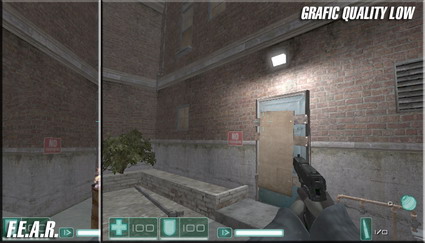New 3D Graphics Card Features in 2006
Top Graphics With The Geforce 7 And Radeon X1x00
The 3D game F.E.A.R. is a good example of how to exploit the effects offered by a 3D graphics card on a PC; the bigger the graphics chip, the better the effects and quality. The images show the details that are lacking if the card is too small and lacks the features offered by the new 3D chips. The 3D shooter really gets going with 3 GHz and Geforce 7; less, and you have to make do with lower resolution, fewer shadow and light effects, and less texture filtering. Graphics cards up to PixelShader 3 are supported.
3D chip on board, Geforce 2: The low graphics capability here means that just about all features are deactivated. There are no visible shader effects, the textures are filtered bilinearly, and shadows are lacking completely.
Geforce 3, Geforce 4, Radeon 9800: At the Low setting the textures are filtered trilinearly, and the overall picture is much sharper. The cracks in the brickwork have real depth. Shadows are still missing, however.
Geforce 5, Radeon X800: The Medium setting shows play of light and shadow. Lighting effects, such as the light from fire, cast a colorful glow on the wall. Up to this point, PixelShader 2 is adequate for the graphics effects on display. If the frame rate is too low, deactivate shadows first.
Geforce 6, 7, Radeon X1x00: With graphics on High, brickwork and stone walls look realistic. The parallax mapping used with PixelShader 3 illustrates grooves and furrows with far great depth than conventional bump mapping (PixelShader 2). In addition, the light produced by flames casts colorful, irregular animated shadows on the wall.
Get Tom's Hardware's best news and in-depth reviews, straight to your inbox.
Current page: Top Graphics With The Geforce 7 And Radeon X1x00
Prev Page Parallax Mapping


